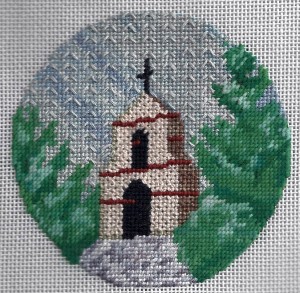
Sometimes an area stitched in Basketweave looks fine as you stitch it, but when you look at it, you find – GASP!- that it’s full of diagonal lines where the color or shade has changed.
Your finished stitching looks something like the project pictured below (although I exaggerated it somewhat for demonstration purposes):
Until recently, I thought this was one of those problems you couldn’t fix. I figured you lived with it or cut it all out and started over.
Thanks to Diane, the owner of Needlepoint, Inc. in San Francisco, I have a great solution.
It’s easy; just stitch over the existing Basketweave with a Blackwork pattern in a matching thread.
The results will look something like this:

The thread I used has large value changes, more than you are likely to find if you’ve done this unconsciously, but even so, you can see how this secondary pattern has downplayed the color changes.
To do this, you will want to use a thread thinner than your thread for Tent Stitch, but still thicker than what you might use for Blackwork on bare canvas. Here I used three strands of floss.
Your thread should match the thread used for the Tent Stitch as closely as possible. You are adding texture here, not color.
Both the basic sky and the Blackwork were stitched using Slate floss from Gentle Arts. I deliberately picked threads with more than the usual variation for the base. The subtler color changes of the Blackwork are more typical of this thread.
Pick a Blackwork pattern that is overall, often called a fill pattern, that matches in scale to your stitched area. It’s also good if it matches in theme. Here, the upside-down V’s look like flying birds, an appropriate choice for a sky.
The denser your pattern, the less the Tent Stitch will show. Originally I had planned to use half this number of motifs, but it didn’t transform the needlepoint as much as the denser pattern.
When stitching Blackwork over Tent Stitches, all stitches need to go over two stitches.
While this technique shines when you have this problem, consider it as well when you want to add more texture to any plain stitching.
About Janet M Perry
Janet Perry is the Internet's leading authority on needlepoint. She designs, teaches and writes, getting raves from her fans for her innovative techniques, extensive knowledge and generous teaching style. A leading writer of stitch guides, she blogs here and lives on an island in the northeast corner of the SF Bay with her family


Good point. I hadn’t thought about it quite that way. 🙂